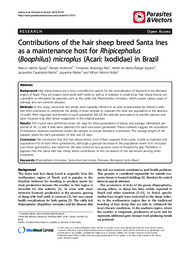Contributions of the woolless sheep as a host for the maintenance of Rhipicephalus (Boophilus) microplus (Acari: Ixodidae) populations in a pasture area in Brazil.
Contributions of the woolless sheep as a host for the maintenance of Rhipicephalus (Boophilus) microplus (Acari: Ixodidae) populations in a pasture area in Brazil.
Author(s): GARCIA, M. V.; ANDREOTTI, R.; REIS, F. A.; AGUIRRE, A. de A. R.; BARROS, J. C.; MATIAS, J.; KOLLER, W. W.
Summary: Abstract: BackgroundHair sheep breeds are a new, cost-effective option for the diversification of livestock in the Midwest region of Brazil. They are grazed extensively with cattle as well as in isolation in small areas. Hair sheep breeds are vulnerable to infestation by parasites such as the cattle tick, Rhipicephalus microplus, which causes various types of damage and can transmit diseases.MethodsIn this study, Santa Inês hair sheep were naturally infested in an area contaminated by infested cattle and then monitored to determine the ability of these animals to maintain the local tick population in the absence of cattle. After engorged tick females of each generation fell off, the animals were placed in another pasture and were returned only after larvae reappeared in the original pasture.ResultsTick counts were performed every ten days for three generations of sheep, and average infestations per animal of 34, 12 and 4 ticks were observed for each successive generation. These numbers suggest the acquisition of resistance; however, additional studies are needed to ensure resistance is achieved. The average length of the parasitic phase for each generation of ticks was 25 days.ConclusionWe concluded that this hair sheep breed, even if kept separate from cattle, is able to maintain tick populations for at least three generations, although a gradual decrease in the population levels of R. microplus over three generations was observed. We also detected two positive cases of Anaplasma spp. Therefore, it appears that the Santa Inês hair sheep breed contributes to the circulation of this bacterium among other ruminants.
Publication year: 2014
Types of publication: Journal article
Unit: Embrapa Goats & Sheep
Observation
Some of Embrapa's publications are published as ePub files. To read them, use or download one of the following free software options to your computer or mobile device. Android: Google Play Books; IOS: iBooks; Windows and Linux: Calibre.
Access other publications
Access the Agricultural Research Database (BDPA) to consult Embrapa's full library collection and records.
Visit Embrapa Bookstore to purchase books and other publications sold by Embrapa.

